(Reuters) - Credit rejection rates were higher in June than earlier in 2024 but slightly lower than a year ago, new data from the Federal Reserve Bank of New York said on Monday.
The bank said that in its June Credit Access Survey, credit rejection rates rose to 21.4% as of last month, relative to the 18.7% rejection rate seen in February. The rejection rate seen in June is just under the 21.8% rejection rate seen the same month a year ago, and flirts with levels last seen in the latter half of 2018.
The uptick in rejection rates comes as fewer households are applying for credit. The bank said that in June applications for any type of credit moved to 41.2% of survey respondents, from 43.4% in February. The survey also found a slight decline in respondents' expectations that they would apply for credit in the future.
Rising headwinds for credit access come as the Federal Reserve has stuck steadfastly at keeping short-term borrowing costs high to bring down elevated inflation. Although some data have pointed to some fraying around the edges of households' financial situations the overall state of the economy has remained relatively strong, and as inflation has decelerated, Fed officials are actively weighing whether to cut their interest rate target soon.
In a research note on Monday, Goldman Sachs Chief Economist Jan Hatzius wrote "we may be approaching an inflection point at which further softening in labor demand results in a bigger and much less welcome increase in unemployment," adding "we see a solid rationale for cutting as early as the July 30-31 meeting."
(Reporting by Michael S. Derby; Editing by Andrea Ricci)
By Michael S. Derby























